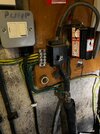Recently our induction hob broke, so I bought a new one thinking it would be a drop in replacement. The circuit has a dedicated 40A breaker.
When I wired it up, it simply wouldn't switch on. We got a replacement for that and... same thing. So the third one we paid extra for John Lewis to install, but they refused saying the Ze return was 1.19 Ohms instead of the "maximum" 0.87 Ohms. They did mention they tested a plug socket and found the same issue. They did say it was only about safety, and wouldn't be the reason the first two didn't work.
We've now called an electrician and they are recommending an R1+R2 test (to see if it's just that circuit), a Ze test (to see if the connection into the house is the issue), and downgrading the MCB to a 32A. We can only find those second hand right now, presumably as it's so old (MK Sentry - LN5932s on eBay).
The wiring/consumer unit is probably 20 years old - and we're probably a year or two off finally doing a full refurb/rewire, so really want to spend the least possible to just get a working hob (safely).
The quotes I've been given are £100+VAT (so £120...) per hour - but noone seems to want to give me a fixed quote, or confirm how many hours (this is Zone 4 London).
I'm just wondering if that's the only option right now? Would the DNO just come and check for free before I go about fixing an issue that might not be internal? Is there anything I can check or narrow down myself?
When I wired it up, it simply wouldn't switch on. We got a replacement for that and... same thing. So the third one we paid extra for John Lewis to install, but they refused saying the Ze return was 1.19 Ohms instead of the "maximum" 0.87 Ohms. They did mention they tested a plug socket and found the same issue. They did say it was only about safety, and wouldn't be the reason the first two didn't work.
We've now called an electrician and they are recommending an R1+R2 test (to see if it's just that circuit), a Ze test (to see if the connection into the house is the issue), and downgrading the MCB to a 32A. We can only find those second hand right now, presumably as it's so old (MK Sentry - LN5932s on eBay).
The wiring/consumer unit is probably 20 years old - and we're probably a year or two off finally doing a full refurb/rewire, so really want to spend the least possible to just get a working hob (safely).
The quotes I've been given are £100+VAT (so £120...) per hour - but noone seems to want to give me a fixed quote, or confirm how many hours (this is Zone 4 London).
I'm just wondering if that's the only option right now? Would the DNO just come and check for free before I go about fixing an issue that might not be internal? Is there anything I can check or narrow down myself?
Last edited:






